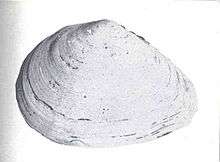Macoma nasuta
| Macoma nasuta | |
|---|---|
 | |
| Scientific classification | |
| Kingdom: | Animalia |
| Phylum: | Mollusca |
| Class: | Bivalvia |
| Order: | Veneroida |
| Family: | Tellinidae |
| Genus: | Macoma |
| Species: | M. nasuta |
| Binomial name | |
| Macoma nasuta (Conrad, 1837) | |
Macoma nasuta is a species of bivalve found along the Pacific Ocean coast of North America. It is often found buried in sands of 10 to 20 centimeters in depth.[1] This rounded clam has no radial ribs and is commonly called the bent-nosed clam.[2] There is archaeological data to support the use of this species by Native Americans such as the Chumash peoples of central California.[3]
Names
Macoma nasuta is commonly known as the Bent-nosed clam or Bent-nose Macoma.[4] It is commonly misidentified as either Macoma tersa or Macoma kelseyi[4]
Description
The hinge plate is without lateral teeth and the length of shell much less than twice the height. Posterior portions of both valves distinctly bent to the right with the siphons distinctly separated (as they are in all Macoma) and have a distinct orange pigmentation. The periostracum is usually very prominent and the shell has a dirty brown wrinkled look to it, especially near the margin.[5]
Distinguishing characteristics
Valves bent rather sharply to the right at the posterior end, orange coloration of its siphons and periostracum is usually very prominent.[4]
Size
About 5 cm at widest point from the anterior end to the posterior end.[6]
Habitat
Common in intertidal and subtidal (50 m) zones; Prefers mud to muddy sand substrates situated in quiet waters and can burrow up to 40 cm beneath the surface sediment. M. nasuta and M. secta are geographically sympatric species and both are the characteristic species of Macoma on the west coast of North America.[7]
Range
Found in the neritic provinces of the eastern Pacific Ocean from Kodiak Island, Alaska, to Cabo San Lucas, Baja California.[8]
Feeding and digestion
Found to feed off the top millimeter of sediment by using a boring motion with the tip of its siphon into the sediment or by using a rotating motion similar to Scrobicularia plana.[9] New sediment is found by moving the siphon into virgin sediment but the clams have also been observed to consume their pseudofeces and feces. It is assumed that the siphon tip is unselective in the particles it intakes.[10]
Non-specific nematodes have been found in the stomach in all stages of digestion from live to empty cuticles. The small (about 500 μm) Bivalve Transenella tantilla has also been found living in the stomach. The relationship with both nematodes and T. tantilla is uncertain.[10]
The exhalant siphon is kept below the sediment surface (about 1 cm). The gut clearance time for inert particles of M. nasuta ranges from 1 to 9 hours with smaller particles and diatoms believed to remain longer than other particles ingested due to their disproportionably high presence in the stomach during dissections.[10]
Bioaccumulation of toxins
Due to their feeding behavior of deposit feeding M. nasuta have been found to have a high level(s) of DDT and PCB’s.[11]
Reproduction
M. nasuta is a dioecious (probably gonochoristic) species that spawns in early summer.[8][12]
Natural history
There is archaeological data to support the use of this species by Native Americans such as the Chumash peoples of central California.[3]
Predators
Shore birds, Lewis' Moon Snail: Polinices lewisii, Starfish: Pisaster spp., Crabs: Cancer productus, Metacarcinus gracilis, Metacarcinus magister.[6]
Known parasites
Graffilla pugetensi[13] is a known parasite of the pericardial cavity and Telolecithus pugetensi[14] is known to use M.nasuta as a second intermediate host in T.pugetensi’s life cycle.
References
- ↑ Macoma nasuta profile
- ↑ Bent-nosed clam
- 1 2 C. Michael Hogan, Los Osos Back Bay, The Megalithic Portal, ed. Andy Burnham (January, 2008)
- 1 2 3 Dave Cowles (2005). "Macoma (Heteromacoma) nasuta (Conrad, 1837)". Walla Walla University.
- ↑ KOZLOFF, E. 1996. Marine invertebrates of the Pacific Northwest, Univ. Wash. Press ISBN 0-295-97562-8
- 1 2 KOZLOFF, E. 2001. Seashore life of the northern Pacific coast, Univ. of Wash. Press ISBN 0-295-96084-1
- ↑ SEPT, J. DUANE 1999. The beachcombers guide to seashore life in the Pacific Northwest, Harbor Publishing ISBN 1-55017-204-2
- 1 2 [RAE III, J.G. 1978. Reproduction in two sympatric species of Macoma (Bivalvia). Biol. Bull. 155: 207-219.]
- ↑ HUGHES, R.H 1969. A study of feeding in Scrobicularia plana. Journal of Marine Biology Assn. U.K. 49: 805-823.
- 1 2 3 HYLLEBERG, J. AND V.F. GALLUCCI 1975. Selectivity in feeding by the deposit-feeding Bivalve Macoma nasuta. Journal of Marine Biology, 32: 167-178.
- ↑ BOESE, B.L., LEE II, H. AND S. ECHOLS 1997. Evaluation of a first-order model for the prediction of the bioaccumulation of PCB’s and DDT from sediment into the marine deposit-feeding clam Macoma nasuta. Setac Journal of Environmental Toxicology and Chemistry. 16:1545-1553.
- ↑ Bivalves of The Evergreen State College Campus
- ↑ SCHELL, S.C. 1986. Graffilla pugetensis n. sp. (order Neorhabdocoela: Graffillidae), A parasite in the pericardial cavity of the bent-nose clam, Macoma nasuta (Conrad, 1837). Journal of Parasitology, 72: 748-754.
- ↑ DEMARTINI, J.D AND PRATT, I. 1964. The life cycle of Telolecithus pugetensis Lloyd and Guberlet, 1932 (Trematoda: Monorchidae). Journal of Parasitology, 50: 101-105.